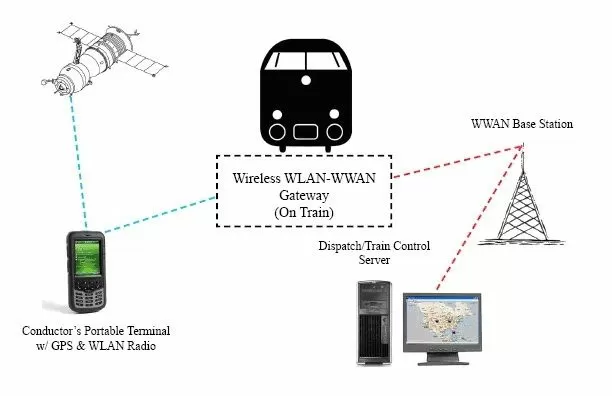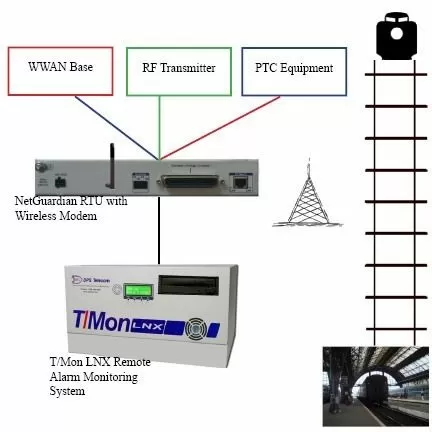Download our free Monitoring Fundamentals Tutorial.
An introduction to Monitoring Fundamentals strictly from the perspective of telecom network alarm management.
1-800-693-0351
Have a specific question? Ask our team of expert engineers and get a specific answer!
Sign up for the next DPS Factory Training!

Whether you're new to our equipment or you've used it for years, DPS factory training is the best way to get more from your monitoring.
Reserve Your Seat TodayPositive train control (PTC) is a developing technology designed to prevent collisions and other accidents on railways. The Federal Government has mandated all railway companies fully implement it by the end of 2015. PTC works by relaying information about the train's location, speed, length, weight, and braking efficiency over a network to a movement authority that then decides how the train should proceed.
The US Rail Safety Improvement Act of 2008 required the implementation of PTC following the deaths of 25 and injury of more than 135 resulting from the collision of a Union Pacific freight train and a Metrolink passenger train. PTC, it is believed, will prevent such disasters in the future. But safety comes at a price - an estimated 10 billion dollars. While the law does provide some funding for the implementation of a robust PTC network, companies will want to protect their mandatory investments in PTC technology with a suitable network monitoring infrastructure.
There are currently two major ways of implementing PTC. The first uses a fixed signaling infrastructure, like coded-track circuits and other "hard" technologies. The other uses GPS and wireless data radios spread out along the rail line and in the trains to transmit dynamic information.

The wireless PTC methodology is generally favored by the FRA, as it is cheaper than the fixed method, provides greater rail visibility, and allows for controls to be executed remotely on trains in emergency circumstances. This all starts with NDGPS, which the Federal Railroad Administration has stated it would like, "To deploy... as a nationwide, uniform, and continuous positioning system, suitable for train control." NDGPS improves upon standard GPS by utilizing a network of ground-based reference stations to broadcast the difference between satellite indicated systems and known physical positions. This gives an even more accurate view of the train's location and speed at every point on its journey.
However, some have questioned the reliability of a wireless PTC network, with many additions to the train-tracking network that could break, causing visibility problems. GPS is only part of the puzzle. Wireless PTC will likely employ an RF band and require network equipment along the rails to keep track of the trains and switches, and provide a vital link between onboard GPS equipment and movement authorities or PTC servers. These will likely be unmanned sites and require some form of network monitoring equipment, like a small to medium NetGuardian series RTU to ensure that they are always operational.
These railway substations will have to relay train location, speed, and direction, set switch requests, give ETAs for railroad crossings, and provide for constant communication with trains to enforce various safety regulations (e.g. temporary speed limitations) or, in emergency situations, bring the train to a safe stop. They'll be subject to the elements, heat, rain, snow, and whatever else could possibly be thrown at them. At each station, railways will likely want to employ a series of temperature and other alarm sensors to ensure that their equipment survives the elements and perhaps a door strike sensor to ensure that they aren't directly accessed without authorization. Small and medium NetGuardian series Remote Telemerty Units (RTUs) are equipped to handle the right complement of alarms and controls and have been proven to withstand the elements, making them the right choice for PTC implementation.
With the wireless PTC systems the FRA is considering, conductors will have access to an "employee-in-charge" portable terminal, giving them access to the network so they may add any relevant data. Remember, PTC does not make conductors obsolete. They remain an important part of the process, with an ability to add additional information and take important, hands-on action via their portable terminal. That makes a solid network monitoring infrastructure even more vital to the implementation of PTC. Without it, should one of the rail-side RF stations, a switch, or any other piece of network equipment fall out, the conductor could lose his own access to the network and, with it, data vital to the hands-on decision making process, and contact with other trains and stations. A simple NetGuardian series RTU at any remote station along the track puts eyes on the equipment and, in many cases, would allow network techs along the line to execute basic controls, helping railway companies keep their PTC networks running, protect their investments in costly PTC technology, and, most importantly, ensure the safety of everyone on the railway.
While PTC networks will provide greater railway visibility and help prevent catastrophes like the Union Pacific-Metrolink crash, it is important to remember that no network should be expected to function perfectly at all times. These railway substations, RF Wireless WAN gateways, and all of the network equipment from train to station will require a robust network monitoring system to help ensure that they are working properly.
